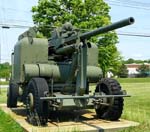 |
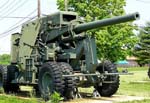 |
 |
| 01 US 90mm M2 Anti Aircraft Gun | 02 US 120mm M1 Anti Aircraft Artillery | 03 US 120mm M1 AAA |
US 90mm M2 Anti Aircraft Gun Specifications:
Length: 15 Feet 6 Inches
Width: Feet Inches
Height: 10 Feet
Caliber: 90mm
Barrel Length: Feet Inches
Muzzle Velocity: 2,700 fps
Rate of Fire: 15-25 rounds per minute
Fire Control: M7 or M9
Crew: 10
Weight: 32,200lbs
Range: 33,000 feet vertical 37,800 feet
Max Range of Gun Control Director: 30,000 feet
Armament:
90mm 23lb projectile
Entered Service: 1943
Unit Cost: $
US 120mm M1 Anti Aircraft Gun Specifications:
Length: 24 Feet 6 Inches
Width: Feet Inches
Height: Feet
Caliber: 120mm L60
Barrel Length: 23 Feet 6 Inches
Muzzle Velocity: 3,100 fps
Rate of Fire: 10-11 rounds per minute
Fire Control: SRC-584 Radar and M4 Gun Data Computer
Crew: 13
Weight: 49,000lbs
Range: 48,000 feet vertical
Armament:
120mm 50lb projectile and 55lb powder case
Entered Service: 1944
Unit Cost: $
Phil Gilson who served as a 120mm M1 gun crew member in the 1950s wrote to help me with some corrections on these pages and to add some more interesting info on the M1 Gun:
"Wikipedia has a nice summary article on the M1 120 mm Gun with dimensions.
The article claims a service ceiling of 60,000 feet but I'm not sure how effective that would have been. Bombing altitude was sometimes as low as 6,000 feet which would certainly have allowed for a longer period of engagement. It also shows a max range of 81,000 but that's with the tube at 45 degrees elevation and the projectile at the apogee of it's flight path before falling back to earth. I can't remember the max duration of the fuse setting but dividing 3100 fps into 81,000 feet gives 26 seconds. Maybe there's some place on the internet that could verify or correct that number.
But the article leaves off with the SCR 584 director. We had M33D (120mm gun) and M33C (90mm gun) fire control systems. Pix of the radar vans with the target tracking antenna as well as the inside of the van showing the computer driven target plotting board in front of the battery commander, the battery switchboard behind him and the optical tracking positions at the rear of the van are shown in this article dealing with Camp Wellfleet in Massachusetts. The article is primarily about the remote controlled aerial targets that we shot at during annual qualification/proficiency testing.
http://www.campwellfleet.com/thercats.html
Somewhere in here (my pc) I've a collection of AA articles. There are piles of stuff on the web. At the bottom of the wikipedia article there are 'related sites' They will provide a broad-brush history of the development of fire control systems for coastal artillery and AA artillery thru and after WW2. What jumps out at me now is the primarily work cited is an Army TM dated 1944. That's old! Really old for the purposes of this discussion.
There is a wonderful site, http://www.cdsg.org, dealing with the history of the Coast Artillery and Harbor defense forts in America from the Revolution up to and including the Nike AA missile. That will take about a month to go thru. The links page might take a year because it contains the unit histories of those outfits sent overseas during WW1 and 2. They also have, in their August 2008 newsletter a link to the scanned and available as pdf files copies of the Coast Artillery journal from 1920 to 1948. What a history of America as it developed in those decades, how the Army perceived itself and what lessons it learned in the Great War, How it wanted to preserve and pass on that info so the next war would find us more ready to put effective soldiers and weapons into the fray.
Ed Thelen from the NPS has a comprehensive site called "Rings of Supersonic Steel" www.ed-thelen.org dealing with the transition to the Nike system.
The only ear protection we had back then was ball of cotton shoved in our ears. I can honestly (and somewhat crudely) say that nobody was constipated after a day on the range firing those things. We didn't have the muzzle blast so much as the shock transmitted from the gun through its mount to the ground and the surrounding area.
Here is a link to a photo showing the M242 Radar van (at the top of the photo). The radar antenna (dish) was stored and shipped inside clamshell doors on the front of the van. While in transit the pedestal was bolted to the floor inside the van The acquisition antenna had its own, open flatbed trailer (M243), The spare parts van, M244, carried the tubs that bolted together to form the base for the Acquisition radar.
This link shows a 90mm M33 installation at Ft Tilden. Scroll down. The first pic shows the 90mm guns emplaced and covered. In the background, in its own tent, is a long range search radar. That was the first part of finding/ acquiring/ selecting a target. The second picture, labeled 'sweep radar' is the emplaced acquisition radar. The third picture is the target tracking antenna installed on the top of the M33 Fire Control System trailer. An easy way to determine whether "its" a 120mm tube is to hold a CD across the muzzle. The CD is 4.7" or 120mm! It's an easy, elegant, beautiful "Go/No go" gauge. It might be easier to extend a folding rule (if you don't have access to a ladder). 4-3/4" is close to 4.7" (Using the old 2.54mm to an inch conversion factor)."
Phil also sent in these scans of the 120mm gun in action in military publications from the 1950s:
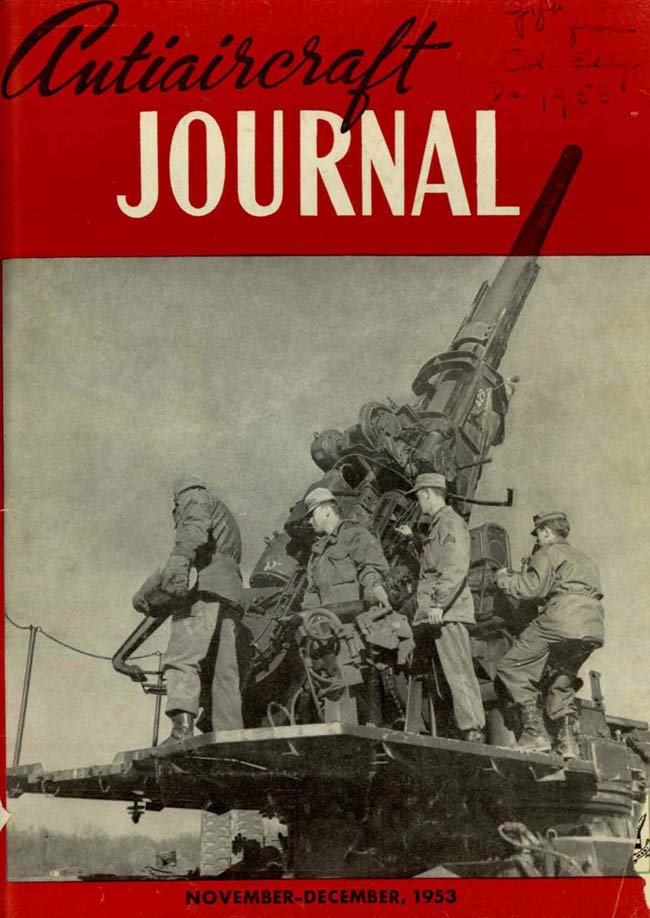 |
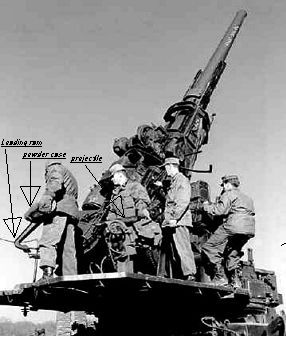 |
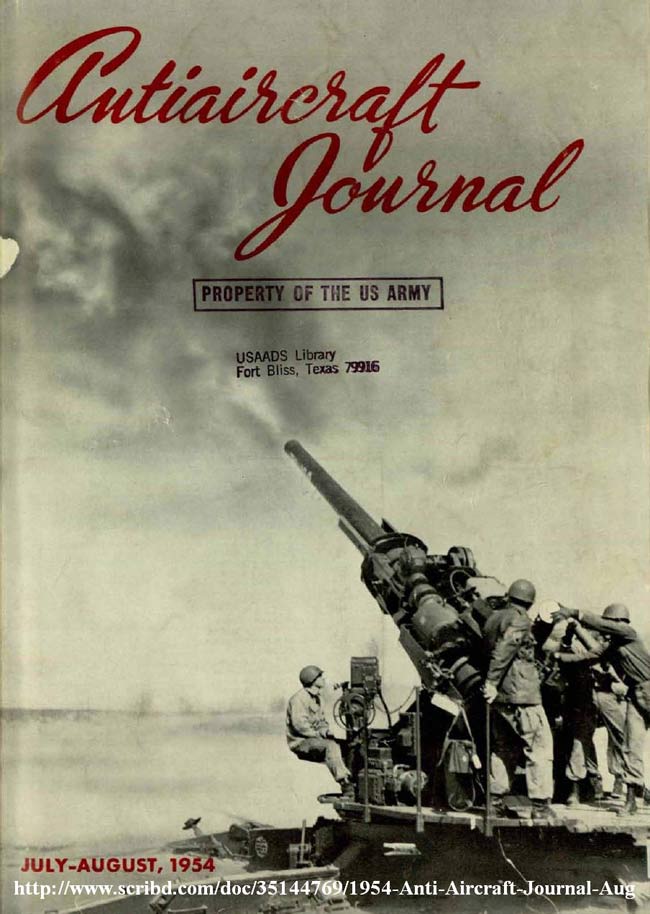 |
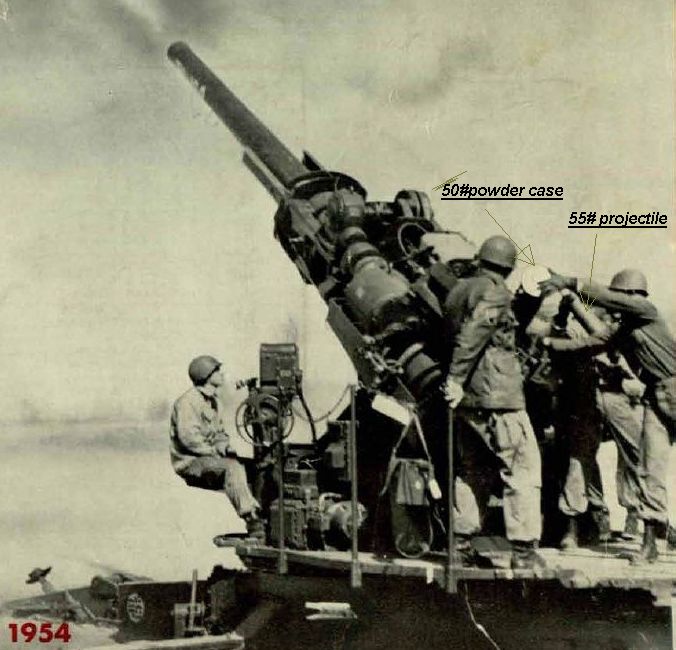 |